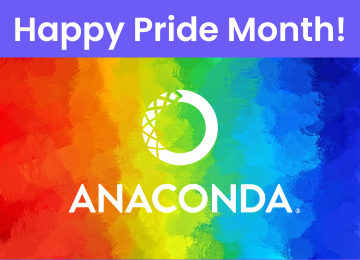Amazing Open-Source AI Successes


With remote-first companies blurring the lines between career and personal life, it’s even more important to spend time learning how to be a good ally and advocate at work. Whether you yourself are a member of the LGBTQIA+ community or not, creating a safe and inclusive space results in happier and more productive workers and encourages employees to stay with a company for the long term.
While inclusivity when it comes to gender and sexual orientation should seem like the bare minimum (and rightfully so), the work of being an ally is more than just posting ‘Love is Love’ on LinkedIn every June. It’s more than companies rainbow washing logos for one month and then supporting anti-trans legislation the next. The work of being a good ally is a lifelong—and vital—commitment.
So how do you be a good ally at work? What should (or shouldn’t) you say? How do you let others know you support them? And how do you potentially balance a clash with your personal belief system?
While we are all raised with certain values and beliefs, the bottom line is that we have to create a physically and psychologically safe workspace for all employees. A person’s status as a member of the queer community has no bearing on their ability to perform their job and their life milestones should be celebrated just as everyone else’s are. The world has long upheld heteronormative standards and binary gender. It’s time we break that.
Though you might disagree or have questions, it’s your job to no longer perpetuate the microaggressions the members of the queer community face on a daily basis. It is not your place to share your opinion on who we date or how we express our gender. It’s your place to respect us just as we respect you.
This looks like inclusive language, not assuming heterosexuality or monogamy, and not assuming or commenting on gender presentation. The buffer of at-home work can ensure physical safety, but monitoring the emotional space of a company (Slack, meetings, etc.) is equally important.
It’s totally natural to have questions, but it’s your responsibility to try and answer those questions on your own before asking others to do the work for you. There are tons of great online and print resources available and some fantastic short guides to act as a primer on language and inclusive practices. While it may be hard to break old habits, it’s work that needs to be done. Check in with your HR and People teams to see if they have any other tools and, if your company has an employee resource group (ERG) for LGBTQIA+ employees, see if they are hosting talks or welcoming questions.
The boon of social media means there are countless resources and guides to turn to. Any question you have, you can find the answer. Just be sure to check sources and try to learn from queer voices on queer issues. Follow therapists and doctors and folks who are sharing their journeys online. Understand that nothing is set in stone—people’s identities can change throughout their lives and that is perfectly normal and okay. It might take a second to start using new pronouns or things may be confusing, but the joy of queer identity is that it’s messy and malleable.
The most important thing to remember is that you never want to out a colleague. Make sure you’re not pressuring anyone to share their status as a member of the LGBTQIA+ community, even if you have the best intentions. Good intentions can result in microaggressions, daily small acts of retaliation, exclusion, or discrimination. Don’t directly ask someone if they are queer in order to say you support them. Instead, let employees share if and when they want to.
For example, if your team is talking about weekend plans and one employee mentions spending time with their partners, don’t make a big fuss. Ask about plans as you normally would. Don’t draw attention to any new details that a team member shares; instead carry on as you always would.
As a team leader, if one of your employees decides to privately share with you that they identify as queer, thank them for sharing and ask if they need anything to feel supported and safe. If a co-worker reaches out questioning the sexual orientation or gender identity of another employee, remind them that these personal details aren’t owed and shouldn’t be speculated on or gossiped over.
Sharing pronouns is a great and easy way to make a workplace more inclusive. You never want to assume pronouns and sharing your own is the best way to set the standard for those around you. Try your best to ask interview candidates their preferred pronouns and include pronouns in Slack profiles, email sign offs, and LinkedIn profiles.
Also, don’t assume hetero or monogamous relationships. Use inclusive language, such as ‘partner’ or ‘partners,’ ‘spouse,’ ‘folks,’ ‘team,’ ‘y’all,’ and others. Do your best to avoid ‘guys’ or other language that can be exclusionary. Again, even if you mean ‘guys’ to include everyone, it’s best to update our language as we learn in order to create the most inclusive space possible.
Language is tricky; it’s often changing, and terminology can feel safe or threatening depending on the person and situation. Some folks have strong opinions about labels and others don’t. Some people embrace the term queer and others see it as a slur. As much as you’re able, try to understand each person’s preference and do your best to be inclusive. LGBTQIA+ (Lesbian, Gay, Bi, Trans, Questioning, Intersex, Ace, plus) is the best way to speak to the wider community until you know if ‘queer’ or another term is preferred. You might hear two people describe their sexuality in the exact same way, but one uses the term ‘bi’ and the other ‘pan.’ Don’t preemptively ask or label; let them tell you. You don’t need to know someone’s exact label or identity. You’re not owed someone’s entire gender or dating journey just because they’re not cis or straight.
Unlearning can be the hardest step, but it’s the most crucial.
Overall, being a good ally comes down to respect. Don’t assume, make sure you’re creating an open and safe environment, and respond to anyone telling you they don’t feel comfortable. You may believe the space and team you’ve created is inclusive, but let the LGBTQIA+ members tell you what’s inclusive and what feels good for them.
Create space, even when it’s difficult or uncomfortable, and treat everyone in your company with courtesy and respect. Psychological and physical safety are needed before we can do our best work, so laying the groundwork and constantly learning is the best way to be an ally and create a safe space for everyone.
Gender: Gender is a social construct; there’s no biological component to gender and it is often the expression of the person and how they chose to present in the world. Because western culture exists in a binary of two genders (male and female), gender expression is usually masculine, feminine, androgynous, all of the above, or none. Our understanding of gender is constantly evolving and expression is unlimited. While binary expression is most commonly accepted, gender performance isn’t owed in order to identify as male or female or nonbinary. For instance, someone who identifies as female doesn’t have to remove their body hair, wear dresses, or take on caretaking roles. Someone nonbinary doesn’t have to be androgynous.
Sexuality: Sexual orientation is generally defined as who you are attracted to and how sexual you are.
Queer: Generally understood to refer to anyone in the LGBTQIA+ community (those not cisgender or not straight).
Cis: Cisgender, or cis, refers to someone who identifies with the sex they were assigned at birth (usually male or female coinciding with genitalia).
Trans: Someone who identifies as a different gender/sex to the one they were assigned at birth. Some trans folks undergo hormone therapy or surgery to better match their body with their feelings and expressions of gender. Not all trans folks medically or socially transition, but this doesn’t dilute their transness.
Intersex: Someone born with parts of different sexual characteristics, genitalia, or chromosomes.
Nonbinary: Or enby, refers to someone who doesn’t identify with male or female and instead exists outside the binary. Some nonbinary folks use all pronouns, some use they/them or other non-gendered pronouns, or a combination.
Polyamory: Polyamory is a form of non-monogamy. Some people have polycules that include multiple partners.
Ace: Ace is used for folks on the asexual spectrum. Some people use the term demi or graysexual, but all refer to a spectrum of sexual desire/interest that is generally lower than most of the population.
Aro: Aro is used for people on the aromantic spectrum. Similar to the asexual spectrum, it is used to refer to romantic interest that is lower than the standard.
Straight: People who are attracted to people of the opposite sex (sometimes tied up with gender).
Bi: Bisexual generally includes people who are attracted to more than one gender or sex.
Pan: Pansexual is often grouped with bisexual as being attracted to more than one identity. For some folks, the distinction is important and pan is generally seen as a wider umbrella more inclusive of trans, intersex, and nonbinary folks (though that doesn’t mean bi isn’t inclusive).
Lesbian: A form of homosexuality wherein people identifying as a woman/female are attracted to women/females.
Gay: Has been used as an umbrella term for all non-straight identities, but more specifically refers to people who identify as man/male who are attracted to men/males.
Talk to one of our experts to find solutions for your AI journey.